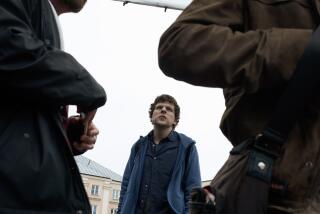The real life Jean Seberg and the tragic tale behind Kristen Stewart’s ‘Seberg’
- Share via
The sad news was announced Sept. 8, 1979. Ten days after actress Jean Seberg had been reported missing, her decomposing body was found wrapped in a blanket in the back seat of her white Renault in Paris. She was only 40.
It was a tragic end to the actress who two decades earlier was a fresh-faced blue-eyed teenager from Marshalltown, Iowa — the daughter of a pharmacist — and won the role of Joan of Arc in Otto Preminger’s 1957 film “St. Joan” out of 80,000 applicants in a nationwide talent search.
Seberg suffered from Preminger’s tyrannical direction and received actual burns during Joan’s death scene on the stake and had to be rescued. She was further scorched by critics for her staid performance.
She later said of the experience: “I am the greatest example of a very real fact, that all the publicity in the world will not make you a movie star if you are not also an actress.”
In 1960, with her short-cropped hair and natural, raw performance, Seberg became an international icon as the girlfriend of a young criminal (Jean-Paul Belmondo) in Jean-Luc Godard’s New Wave French masterpiece “Breathless.” Throughout the 1960s, she had one foot in Paris and one foot in Hollywood. She married her second husband, noted writer Romain Gary (“The Roots of Heaven”), 24 years her senior, in 1962 and had their son, Diego, earlier the same year.
When the actress returned to Hollywood in 1968 to make “Paint Your Wagon,” Airport” and “Macho Callahan,” the FBI became interested in her because not only had she donated money to the Black Panthers, she had begun an affair with a married African American activist.
Its smear campaign claimed Seberg was pregnant with a Black Panther’s child (L.A. Times’ gossip columnist Joyce Haber publicized it in a thinly veiled post), causing her to go into premature labor and give birth to a daughter, Nina Hart Gary. The little girl died two days later and was buried in Marshalltown but not before her coffin was opened to prove the baby was white.
The new film “Seberg,” starring Kristen Stewart as the actress, explores the plot by COINTELPRO, the FBI’s counter-intelligence program, to discredit her support of the Panthers and other African American causes by publicizing her pregnancy, saying it “felt the publication of Miss Seberg’s plight could cause her embarrassment and serve to cheapen her image with the general public.”
A paranoia-style thriller in the vein of such 1970’s classics as Alan J. Pakula’s “Klute” and Francis Ford Coppola’s “The Conversation,” the movie, now playing in limited release and opening wider on Friday, also stars Anthony Mackie as Hakim Jamal, a leader in the Black Power movement with whom Seberg became lovers, and Jack O’Connell and Vince Vaughn as FBI agents assigned to Seberg’s case.
Married screenwriters Anna Waterhouse and Joe Shrapnel had long been fascinated with Seberg. In fact, Shrapnel’s grandmother was Deborah Kerr, who appeared with Seberg in 1958’s “Bonjour Tristesse,”also directed by Preminger.
“I spoke to Deborah, and Deborah said ‘Oh, it’s terrible what happened to her and what they did to her,’ ” he recalled. “I got the first hints of what a fascinating character Jean must be.“
Setting the film during this time, said Waterhouse, was a way to make a film about Jean Seberg “but also about the period of American history I was fascinated by. I saw this as an amazing opportunity to, I guess, write a political thriller but also to explore who Jean Seberg was.”
Kristen Stewart stars as French New Wave actress Jean Seberg as she is targeted by the FBI for her political and romantic involvement with a civil-rights activist.
“Seberg” director Benedict Alexander sees the film as a “a portrait of an actress becoming undone. As someone who’s worked with some of the world’s truly great actresses, [and] whether it’s onstage or in front of the camera, [they] lay bare their most private spaces. I found it fascinating how this is exactly the space that the FBI exposes and destroys. They look into that private space.”
Actress-producer Diane Baker (“The Diary of Anne Frank,” “Marnie”) was friends with Seberg during this period. She had known Gary before he married Seberg, and he introduced her to Baker.
“He thought if she’s going to make movies and be here, I was the one person she should get to know because I would be more aligned with her sensitivities, her beliefs and so on,” Baker said. “She was having difficulties with her interest in politics. It wasn’t even politics; it was her need to help the African American community in Los Angeles. I hardly had met anyone my age that was intellectually curious.”
Seberg even brought Jamal to Baker’s Beverly Hills apartment. “When he came in the door, her first words were: ‘I want you to meet Diane. She’s the only person you can trust in Hollywood.’ He was very polite,” Baker continued. “She helped him and his wife and children move out of their home near Compton. They couldn’t live there anymore. They were fearing for their lives. She moved them to her house in Coldwater Canyon she was renting.”
Baker recalled the one time she went to visit Seberg, she was shocked to see all the windows boarded up on the Coldwater-facing side of the house. “I said, ‘Jean, why are these boarded up?’ She said, ‘You never know.’ I saw how caring she was and how she was literally trying to save lives.”
Seberg, she said, “cared about the plight of people less fortunate than her. All she thought about was caring and wanting to do good. She looked at the people less fortunate than herself and felt guilty for having [money]. I think Jean was so supersensitive that her understanding of politics was probably naive.”
The two shared the same makeup man; Baker recalled him calling her while he was working in Oregon on the set of “Paint Your Wagon” with Seberg. “He said she’s offering money to people on the set, the hairdresser, makeup, anybody who needed it, she’s just giving it to them.”
Christa Fuller, the widow of maverick director Samuel Fuller (“The Steel Helmet,” “The Big Red One”), met Seberg during the time she was in Los Angeles and donated $25 to her for the Black Panthers. “She was very sweet,” said Fuller, adding the actress put so much “energy and persuasion into doing the right thing. I think her whole life [she] was on that march of being a savior, of being the real modern Joan of Arc.“
During the filming of 1970’s “Macho Callahan” in Mexico, Seberg had an affair with a young Mexican revolutionary named Carlos Ornelas Navarra, whom Seberg said was Nina’s father..
She also had an affair with acclaimed novelist Carlos Fuentes, who wrote a novel about their relationship, “Diana: The Goddess Who Walks Alone.”
Diane Ladd, who appeared in “Macho Callahan,” recalled that Seberg and star David Janssen (TV’s “The Fugitive”) became very close during production.
“I don’t know how deep the friendship went,” said Ladd. “But they were wonderful people to work with.”
Seberg, she noted, was “very gracious, very giving. She was very, very vulnerable — a delicate flower. I loved working with her. Everybody did.”
After “Macho Callahan” and the death of her daughter, Seberg returned to France and never returned to Hollywood. Though she and Gary divorced in 1970, they remained close and even lived across from each other in the same apartment building.
Baker recalled that Gary was worried about Seberg. “He said, ‘It’s like holding in a huge glass bowl that’s cracked and I’m holding the whole thing. I’m trying to hold it all in my hands.’ ”
Shortly after Seberg’s body was found, the FBI announced that agents had attempted to besmirch her reputation in 1970. And Gary called a news conference to tell the world that the baby in question was his and the FBI had destroyed his ex-wife’s life. According to Gary, she had tried to kill herself every year on the anniversary of Nina’s death. And Seberg said in a 1974 interview, she had “cracked up” after Nina’s death.
Gary died by suicide the following year. “It was too much for him,” said Baker.
Doubts continue to swirl around Seberg’s death. “Antoine and I both could not believe the death to be self-inflicted,” said Alain Mamou-Mani, who wrote the new French novel “Kill Jean” with Antoine Lassaigne.
“Forty years later, a sign was placed on her grave in Montparnasse saying, ‘Jean, your killers are still around,’ ” said Mamou-Mani. “The cause of her death is as mysterious as Marilyn [Monroe]’s.”
More to Read
Only good movies
Get the Indie Focus newsletter, Mark Olsen's weekly guide to the world of cinema.
You may occasionally receive promotional content from the Los Angeles Times.











